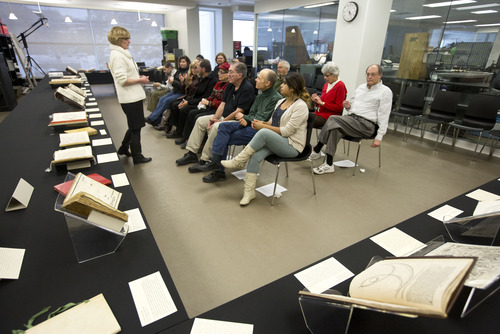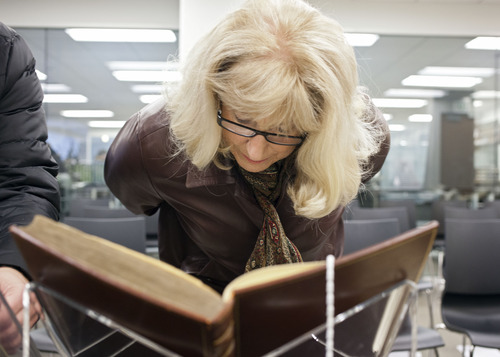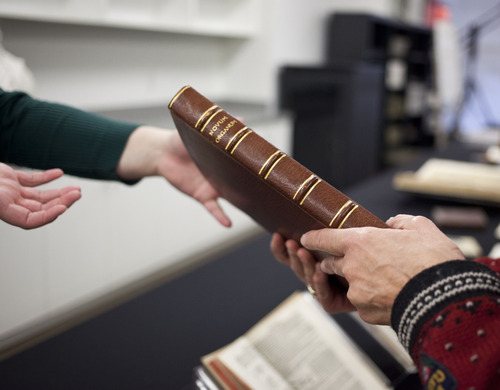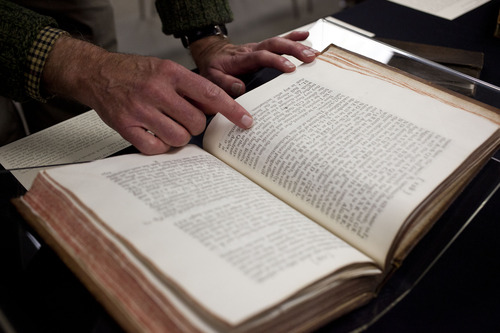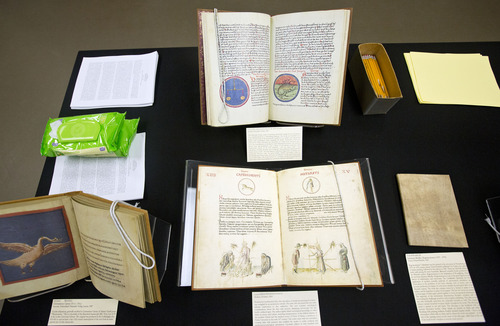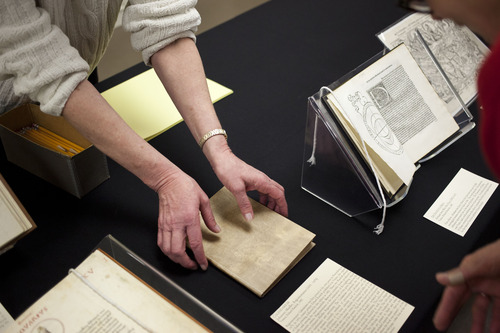This is an archived article that was published on sltrib.com in 2013, and information in the article may be outdated. It is provided only for personal research purposes and may not be reprinted.
Delighted giggles and amazed gasps punctuated the otherwise reverent room.
Amateur astronomers gathered at the University of Utah's J. Willard Marriott Library to touch original editions of books that laid the foundation for astrophysics, stargazing and our understanding of the universe.
A 1687 first edition of Isaac Newton's Principia, in which he revolutionized humanity's understanding of universal laws of phenomena such as gravity, is one of only 300 in the world. The book is valued at $300,000, but its worth is far beyond that.
"To the astronomer, this is the Bible," said Patrick Wiggins, the Stansbury Park resident and amateur astronomer who organized the trip for about 15 people, mostly members of the Salt Lake Astronomical Society, as he held the book. "This is an emotional experience."
The oldest books on display were from the 800s and ranged to Einstein's work in the early 1900s. The vast majority of the 39 books were first editions still in their original binding and were perfectly legible hundreds of years after their creation.
"The information in these books was important, so they cared for them," said Luise Poulton, managing curator of rare books at the library. "They used them, but they really cared for them."
The books are in such excellent condition that in books such as Giovanni Paolo Gallucci's 1607 work, Theatro del mundo y de el tiempo, there is a vovelle, which is a wheel chart with moving pieces, that still turns and works as a calculator.
The 1661 illuminated text Harmonia Macrocosmica by Andreas Cellarius features some of the best examples of 17th-century Dutch cartography, and the gold foil and hand paintings still have their lustre. Other books featured a frontispiece, which is basically an illustrated title page. In the 1620 Novum Organum by Francis Bacon, the frontis is of a ship sailing beyond the Pillars of Hercules, representing the need to move beyond a classical understanding of the world and into uncharted territory, Poulton said.
Another frontispiece in Galileo's 1632 Dialogo depicts three guys on the street corner, just chatting. The book was in Italian, not Latin, so it took the power away from the church and scholars and put it in the hands of the common man. While the illustration wanted to convey a nonthreatening message, Galileo still finished his life under house arrest for heresy for stating that the Earth revolved around the sun.
"These turned out to become incredibly important books," Poulton said. "If you want to destroy a culture and conquer a people, that's why you go for the library. It speaks to the power of the written word. It breaks my heart, but it is consistent with war. But look how much this means to people. Look at how powerful this is 400 years later. You have a group of grown people standing here going 'Oh my gosh.' "
Two of those people were Tooele residents Tera and Steve Peay. They came after receiving an email from Wiggins asking them if they'd be interested.
"There are certain books in history that are a turning point in scientific thought," Steve Peay said. "Being able to see and hold these books is a once-in-a-lifetime experience."
Tera Peay said she was impressed with the intelligence of the writers.
"I just can't believe how advanced they were, and they took the time to hand-paint these books," she said. "It's amazing to see how much of their souls they put into these books."
About 40 groups outside the University of Utah a year visit the Marriott Library's rare-book collection, which is funded by taxpayers and private donations. Anyone can request a specific book and can hold it and read it as soon as a librarian can get it from the collection, Poulton said.
Fred Swanson, a Salt Lake resident and amateur astronomer, was delighted to be in the presence of such masterpieces.
"These are some of the founding documents of Western science," Swanson said. "To see them is a real thrill. I've always been interested in astronomy and physics, and our textbooks are all derived from these books by Kepler and Newton and Einstein. It's simply a thrill."
Twitter: @sheena5427



